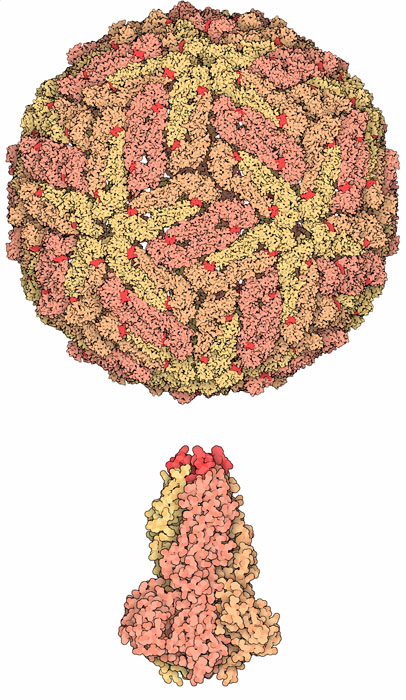|
Inhaltsübersicht | Nanomaschinen | Moleküle | Programme | Kurse | Fun | Links |
||
| > |
Dengue Virus
Dengue virus is a major threat to health in tropical countries around the world. It is limited primarily to the tropics because it is transmitted by a tropical mosquito, but even with this limitation, 50-100 million people are infected each year. Most infected people experience dengue fever, with terrible headaches and fever and rashes that last a week or two. In some cases, however, the virus weakens the circulatory system and can lead to deadly hemorrhaging. Researchers are now actively studying the virus to try to develop drugs to cure infection, and vaccines to block infection before it starts.
The Dengue Virus Genome
Dengue virus is a small virus that carries a single strand of RNA as its genome. The genome encodes only ten proteins. Three of these are structural proteins that form the coat of the virus and deliver the RNA to target cells, and seven of them are nonstructural proteins that orchestrate the production of new viruses once the virus gets inside the cell. The outermost structural protein, termed the envelope protein, is shown here from PDB entry 1k4r. The virus is enveloped with a lipid membrane, and 180 identical copies of the envelope protein are attached to the surface of the membrane by a short transmembrane segment. The job of the envelope protein is to attach to a cell surface and begin the process of infection.
A Deadly Switch
In the infectious form of the virus, the envelope protein lays flat on the surface of the virus, forming a smooth coat with icosahedral symmetry. However, when the virus is carried into the cell and into lysozomes, the acidic environment causes the protein to snap into a different shape, assembling into trimeric spike, as shown at the bottom from PDB entry 1ok8. Several hydrophobic amino acids at the tip of this spike, colored bright red here, insert into the lysozomal membrane and cause the virus membrane to fuse with lysozome. This releases the RNA into the cell and infection starts. The hemagglutinin protein on the surface of influenza virus plays a similar role, but the two proteins use entirely different mechanisms to perform a similar task.
The Hunt for a Dengue Vaccine
A dengue vaccine has proven difficult to develop, in part because there are four major subtypes of dengue virus, each with slightly different viral proteins. Many researchers currently believe that the deadly dengue hemorrhagic disease is caused when a person is infected with one subtype, and then infected later by a second subtype. The antibodies, and immunity, gained from the first infection appear to assist with the infection by the second subtype, instead of providing a general immunity to all subtypes. This means that an effective vaccine will have to stimulate protective antibodies against all four types at once, a feat that has not yet been achieved.
Next: Building New Viruses

Last changed by: A.Honegger,